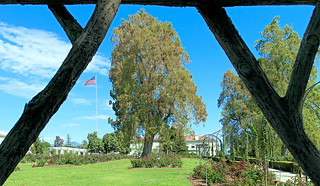There are a number of methods available that will allow you to create your own thriving, healthy organic garden. Just learn some techniques, and put the ones that resonate with you into practice.
When selecting among several varieties of a plant, choose the ones that will produce the largest yield. A hybrid designed for your weather, and resistant to local diseases, will give a better yield than non-hybrids.
Plant seeds in pots that have a rich soil to give them a strong start. They are then more likely to survive and to become thriving, mature plants. In addition, it lets you tighten the time in between plantings. When you take out the prior set of adult plants, your seedlings will then be prepared to go in.
Turn your tool handles into convenient rulers. It is possible to utilize tools with long handles, such as rakes, hoes and shovels, as measuring sticks. Lay the handles onto the floor and place a measuring tape beside them. Then, with a permanent marker, you want to label distances. When you are at work in the garden, you will always have a handy measuring device on each and every tool.
Flower Garden
Plant a variety of flowers to keep your flower garden colorful and interesting. Annuals and biennials can add excitement and interest to your flower garden every season. Annuals and biennials that grow quickly can really wake up your flower beds, and they allow you to have a new garden look every season or every year, if you choose to. In addition, you might need something to fill empty spaces in your flower garden. Fill gaps with annuals or biennials. Just make sure the flowers will get enough sun to thrive. Some varieties are hollyhocks, petunias and sunflowers.
Ensure you have the proper soil for the plants you have selected. The kind of plants you want in your garden should let you know what kind of soil you need to get. It is also possible to make an artificial area using only one type of soil.
The first thing you should do when planning a garden is test the soil. Many nurseries offer a soil analysis service, which will tell you what nutrients your soil is lacking and what you can do about it. You can often find Cooperative Extension offices that provide this service, which can help to make your garden flourish.
Before you start planting your garden, plan it out. Use this to remind you where certain things were planted, later when they start sprouting. It can also aid in identifying the less prominent fledgling plants that lie withing a larger landscaped garden.
Create your own garden from scratch with seeds, rather than plants. Starting from seed is far less harsh on the environment than using plants you buy at the nursery. The plastic used in nurseries often end up in landfills, that is why it is advised to use seeds or purchase from nurseries that make use of organic materials when packaging their plants.
Fertilize your garden. Manure is great in enabling plants to grow, although it’s vital to use commercially composted products in order to lessen the risk of a variety of pathogens. You have the ability to choose from quite a large array of fertilizer, however there is not a great difference between them. It is just crucial that you use something.
It is possible to use natural materials as well as other plants to help keep pests away from your garden. A border of onions or marigolds around a vegetable garden can repel slug. Wood ash, when used as mulch, can help keep insects away from trees and shrubs. With these natural methods, there is no need to purchase expensive, harsh pesticides.
Read instructions on new horticulture chemicals and tools before you use them. You might end up damaging your plants or getting a skin irritation. Following instructions for the use of harsh chemicals can keep you safe from serious injury.
Keep the temperature in your home between 65 and 75 degrees Fahrenheit, if you are keeping or growing any kind of plant in your house. Plants need to be in an environment that is neither too warm nor too cool for them to grow. If this is a little too warm for your house, grow your organic plants under a heat lamp.
Have some plastic bags on hand that you can put over your gardening shoes if they are muddy. You will save time and be back in the garden much more quickly by doing this.
While horticulture organically requires more work than gardening with the help of chemicals, the rewards are worth it. While chemical pesticides and fertilizers may claim to do great things for your garden, organic methods will give you the best crops possible.
If you have been thinking about getting into horticulture, you should first learn how to lay the foundation. The first thing to do is use a spade and cut under the turf. Once that is done, turn it over and cover with about three to four inches of mulch. Give it a few weeks and you can start to plant your plants.
To mulch, trees and flowers, use a minimum of three inches of organic material. Doing this will benefit the environment, as well as reduce your water bills. Don’t worry about how your garden will look using this method. It’ll look wonderful.
Plant garlic in different places to keep the bugs away. Garlic functions as a repellent for many insects. Be sure to plant the garlic around the perimeter of the garden and near pest-attracting plants. You can also eat the garlic when you plant it.
Any person can create a garden. However, only those who possess the right information will receive the most benefit from their garden. Use the organic tips in this article.
